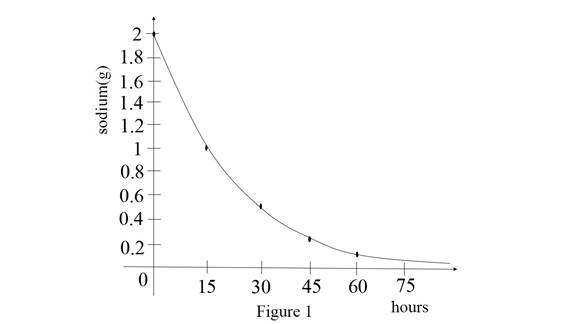
Concept explainers
(a)
To find: The amount remaining isotope of sodium after 60 hours.
(a)
Answer to Problem 32E
The amount remaining isotope of sodium after 60 hours is 0.125g.
Explanation of Solution
Given:
The half-life of sodium is 15 hours.
The mass of sample sodium = 2g.
Calculation:
Let
That is
After 15 hours the amount of sodium is
Substitute 2g for
After 30 hours the amount of sodium
Substitute 1g for
After 45 hours the amount of sodium is
Substitute 0.5g for
After 60 hours the amount of sodium is
Substitute 0.25g for
Therefore, the amount sodium after 60 hours is 0.125g.
(b)
To find: The amount of sodium after t hours.
(b)
Answer to Problem 32E
After t hours amount of sodium is
Explanation of Solution
Calculation:
Consider half –life sodium amount in 15 hours =
Where
After
Therefore after t hours amount of sodium as follows,
Substitute
Therefore, after t hours amount of sodium is
(c)
To estimate: The remaining amount of sodium after 4 days.
(c)
Answer to Problem 32E
After 4days the amount of sodium is
Explanation of Solution
Given:
Consider after 15 hours the amount of sodium = 1g.
Calculation:
After 15 hours the amount of sodium is
By using part (b) solution
Obtain the amount after 4 days that means 96 hours.
Substitute 96 for t in
Therefore, after 4 days the amount of sodium is
(d)
To estimate: The amount of bismuth reduced to 0.01g.
(d)
Answer to Problem 32E
The amount of sodium amount reduced to 0.01g for 38.2215 days.
Explanation of Solution
Given:
The reduced amount of sodium = 0.01g.
Graph:
Let x axis for hours and y axis for sodium (g).
Use the online graphing calculator and draw the graphs for sodium level and hours as shown below Figure 1.

Observe the graph an initial stage sodium amount is 2g.
Then after 15 hours the mass is reducing to 1g.
After 30 hours the mass is reducing to 0.5g.
After 45 hours mass is reducing to 0.25g.
After 60 hours mass is reducing to 0.125g.
Therefore, the mass of sodium is reducing when the hours are increasing.
Calculation:
From the graph, the general form of sodium after t hours
Substitute 0.01 for
Take naturel logarithm on both sides,
Simplify further,
Therefore, the amount of sodium reduced to 0.01g for 114.6645 hours.
Chapter 1 Solutions
Single Variable Calculus: Concepts and Contexts, Enhanced Edition
- For the curve defined by r(t) = (e** cos(t), et sin(t)) find the unit tangent vector, unit normal vector, normal acceleration, and tangential acceleration at t = πT 3 T (1) N Ň (1) 133 | aN = 53 ar = = =arrow_forwardFind the tangential and normal components of the acceleration vector for the curve - F(t) = (2t, −3t³, −3+¹) at the point t = 1 - ā(1) = T + Ñ Give your answers to two decimal placesarrow_forwardFind the unit tangent vector to the curve defined by (t)=(-2t,-4t, √√49 - t²) at t = −6. T(−6) =arrow_forward
- An airplane flies due west at an airspeed of 428 mph. The wind blows in the direction of 41° south of west at 50 mph. What is the ground speed of the airplane? What is the bearing of the airplane? 428 mph 41° 50 mph a. The ground speed of the airplane is b. The bearing of the airplane is mph. south of west.arrow_forwardRylee's car is stuck in the mud. Roman and Shanice come along in a truck to help pull her out. They attach one end of a tow strap to the front of the car and the other end to the truck's trailer hitch, and the truck starts to pull. Meanwhile, Roman and Shanice get behind the car and push. The truck generates a horizontal force of 377 lb on the car. Roman and Shanice are pushing at a slight upward angle and generate a force of 119 lb on the car. These forces can be represented by vectors, as shown in the figure below. The angle between these vectors is 20.2°. Find the resultant force (the vector sum), then give its magnitude and its direction angle from the positive x-axis. 119 lb 20.2° 377 lb a. The resultant force is (Tip: omit degree notations from your answers; e.g. enter cos(45) instead of cos(45°)) b. It's magnitude is lb. c. It's angle from the positive x-axis isarrow_forwardFind a plane containing the point (3, -3, 1) and the line of intersection of the planes 2x + 3y - 3z = 14 and -3x - y + z = −21. The equation of the plane is:arrow_forward
- Determine whether the lines L₁ : F(t) = (−2, 3, −1)t + (0,2,-3) and L2 : ƒ(s) = (2, −3, 1)s + (−10, 17, -8) intersect. If they do, find the point of intersection. ● They intersect at the point They are skew lines They are parallel or equalarrow_forwardAnswer questions 2arrow_forwardHow does a fourier transform works?arrow_forward
- Determine the radius of convergence of a power series:12.6.5, 12.6.6, 12.6.7, 12.6.8Hint: Use Theorem12.5.1 and root test, ratio test, integral testarrow_forwardCan you answer this question and give step by step and why and how to get it. Can you write it (numerical method)arrow_forwardCan you answer this question and give step by step and why and how to get it. Can you write it (numerical method)arrow_forward
 Calculus: Early TranscendentalsCalculusISBN:9781285741550Author:James StewartPublisher:Cengage Learning
Calculus: Early TranscendentalsCalculusISBN:9781285741550Author:James StewartPublisher:Cengage Learning Thomas' Calculus (14th Edition)CalculusISBN:9780134438986Author:Joel R. Hass, Christopher E. Heil, Maurice D. WeirPublisher:PEARSON
Thomas' Calculus (14th Edition)CalculusISBN:9780134438986Author:Joel R. Hass, Christopher E. Heil, Maurice D. WeirPublisher:PEARSON Calculus: Early Transcendentals (3rd Edition)CalculusISBN:9780134763644Author:William L. Briggs, Lyle Cochran, Bernard Gillett, Eric SchulzPublisher:PEARSON
Calculus: Early Transcendentals (3rd Edition)CalculusISBN:9780134763644Author:William L. Briggs, Lyle Cochran, Bernard Gillett, Eric SchulzPublisher:PEARSON Calculus: Early TranscendentalsCalculusISBN:9781319050740Author:Jon Rogawski, Colin Adams, Robert FranzosaPublisher:W. H. Freeman
Calculus: Early TranscendentalsCalculusISBN:9781319050740Author:Jon Rogawski, Colin Adams, Robert FranzosaPublisher:W. H. Freeman
 Calculus: Early Transcendental FunctionsCalculusISBN:9781337552516Author:Ron Larson, Bruce H. EdwardsPublisher:Cengage Learning
Calculus: Early Transcendental FunctionsCalculusISBN:9781337552516Author:Ron Larson, Bruce H. EdwardsPublisher:Cengage Learning





